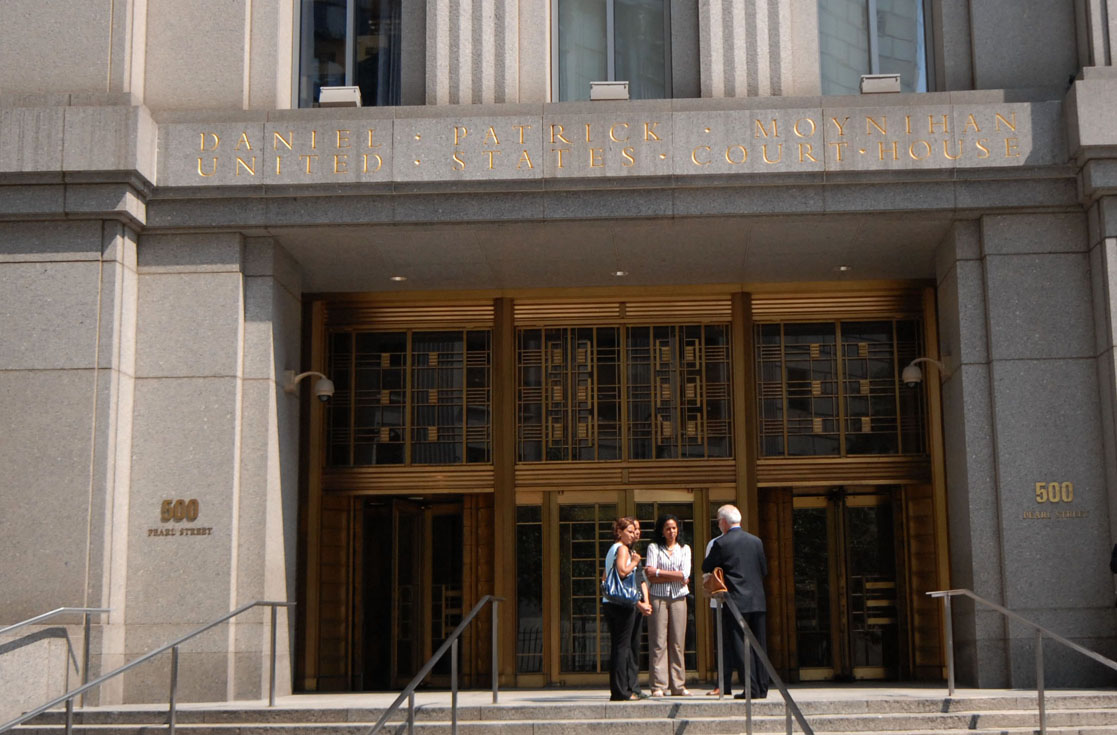Substantial Differences in Substantial Assistance Within the Second Circuit
District judges can vary from the U.S. Sentencing Guidelines for almost any reason, but the most common path to a sentence significantly below the Guidelines range is a downward departure under Guideline §5K1.1, which is the primary vehicle by which a criminal defendant's cooperation with federal authorities—his “substantial assistance”—is incentivized and rewarded. The basic procedure is the same in every district. Yet cooperation yields different results depending on the district.
January 25, 2019 at 03:30 PM
8 minute read
 U.S. District Court for the Southern District of New York – 500 Pearl Street. (Photo: Rick Kopstein)
U.S. District Court for the Southern District of New York – 500 Pearl Street. (Photo: Rick Kopstein)
Since their inception, the U.S. Sentencing Guidelines have been widely criticized for the draconian sentences they produce. The Guidelines' influence was somewhat lessened in 2005, when the U.S. Supreme Court held that although district judges could consider the Guidelines when imposing a sentence, they could not, consistent with the Sixth Amendment, be bound by them. See United States v. Booker, 543 U.S. 220 (2005). But even after Booker, the Guidelines remain the single most powerful factor in determining a federal criminal defendant's sentence. For counsel representing a defendant at sentencing, resisting the Guidelines is of paramount importance. District judges can vary from the Guidelines for almost any reason, but the most common path to a sentence significantly below the Guidelines range is a downward departure under Guideline §5K1.1, which is the primary vehicle by which a criminal defendant's cooperation with federal authorities—his “substantial assistance”—is incentivized and rewarded.
The basic procedure is the same in every district: the prosecutor decides whether to move for a departure under §5K1.1, while the sentencing judge decides whether to grant the motion and, if so, by how much to depart. Yet that cooperation yields different results depending on the district. According to a 2016 report from the U.S. Sentencing Commission, the extent of departure under §5K1.1—that is, the percentage decrease that the average sentence is from the average minimum of the Guideline range applied in a case—was as follows:
(1) Southern District of New York—85.5 percent
(2) District of Vermont—83.1 percent
(3) Eastern District of New York—81.6 percent
(4) District of Connecticut—70.2 percent
(5) Western District of New York—56.4 percent
(6) Northern District of New York—55.9 percent
See U.S. Sentencing Commission, The Use of Federal Rule of Criminal Procedure 35(b) (January 2016). Not only was the extent of departure much greater in the Southern District, District of Vermont and the Eastern District, but the average sentence imposed was also much less. In the Southern District, for example, the average sentence for a defendant who received a §5K1.1 departure was 25 months; in the Western District, it was 38 months.
The most likely reason for these stark differences is variation—both cultural and procedural—in the way that cooperation agreements are struck, and the motions and departures that result. A comparison of practice in the Southern District with practice in the Western District illustrates the point.
Southern District Practice
Cooperation in the Southern District, at least when given directly to the U.S. Attorney's Office, begins with the execution of a proffer agreement. Cooperation that the government deems truthful and potentially helpful usually results in cooperation provisions being included in a letter-form plea agreement. Also known as a cooperation agreement, this document describes the defendant's cooperation and the possibility that the government will file a §5K1.1 motion if it determines that the defendant fulfilled his obligations to provide “substantial assistance.” The cooperation agreement does not say that the §5K1.1 motion will seek a departure of any particular number of levels.
If the defendant provides substantial assistance, the government will file its §5K1.1 motion or letter before sentencing. The motion will explain what the defendant did to assist the government (e.g., met with agents, testified before the grand jury, etc.), and describe how his assistance aided the government in investigating and prosecuting others. Like the cooperation agreement, the §5K1.1 motion does not ask the sentencing judge to depart any particular number of levels; it simply summarizes the defendant's cooperation and leaves the judge to determine the size of the departure based on the government's summary and input from defense counsel.
This deference to the sentencing judge more equally apportions §5K1.1 authority between the government and the district court. The government still controls initial access to an otherwise unattainable sentence, and is therefore in a position to extract cooperation from defendants. But once the government's motion is made, the sentencing judge independently decides how much the defendant's cooperation is worth. And Southern District judges tend to reward substantial assistance with substantial downward departures under §5K1.1—especially, it seems, when the cooperator testifies against others. The result is comparatively short sentences for cooperators, a powerful incentive to cooperate, and a meaningful check against the Guidelines' harshness.
Western District Practice
Western District practice starts in a similar way. Cooperation directly with the U.S. Attorney's Office for the Western District of New York begins with a standard proffer agreement in letter form. If the defendant's information is deemed truthful, it may lead to a cooperation provision being included in a plea agreement that is signed shortly before the guilty plea.
From here, however, Western District practice diverges. In cases where the proffer leads to a plea agreement with a cooperation provision, the plea agreement usually provides that the government will move the sentencing judge to depart a set number levels. Sometimes, the agreement will be that the government will depart at least a set number of levels, to account for uncertainty regarding how much more cooperation will take place, whether co-defendants will plead as a result of the cooperation, and whether the cooperator will testify at trial. In rare cases, the plea agreement says simply that the government will make a §5K1.1 motion.
Western District practice diverges further before and during sentencing. When the government makes its §5K1.1 motion in the Western District, it almost always moves the sentencing judge to depart a specific number of levels. The requested departure is typically small—usually between two and five levels, depending on the amount of cooperation. And in almost (but not quite) all cases, the sentencing judge departs the exact number of levels the government recommends. (Judges in the Rochester Division appear slightly more likely to increase the size of the departure beyond the number of levels the government recommends.) This very conservative §5K1.1 practice is deeply ingrained in the Western District, and has been for decades. The result is that, in the Western District, §5K1.1 departures are smaller, the government plays a greater role in valuing a defendant's cooperation and determining his ultimate sentence, and cooperation is less appealing to defendants.
Options for Defense Counsel
Apart from seeking non-Guidelines sentences, variances, and dispositions under Federal Rule of Criminal Procedure 11(c)(1)(C), the options for the defense practitioner in pursuing the largest possible departure under §5K1.1, whether in the Western District or otherwise, are not new.
First, defense counsel's sentencing presentation should always canvass his client's cooperation, and describe the risks and difficulties endured, as part of advocating for the lowest possible Guidelines range and, ultimately, a non-Guidelines sentence. This should be covered in both the sentencing allocution and in the sentencing memorandum that is submitted in advance of sentencing. Even fulsome §5K1.1 letters do not always convey the full extent of a defendant's cooperation.
Second, in districts where the government takes a position on how many levels the sentencing judge should depart under §5K1.1, counsel can and should urge the judge to depart further. See, e.g., United States v. Udo, 963 F.2d 1318, 1319 (9th Cir. 1992). This is an uphill climb in districts like the Western District, where judges seem to give the government's recommendation near dispositive weight. But such an argument is occasionally successful.
Third, post-Booker, a sentencing judge can consider and account for cooperation under 18 U.S.C. §3553(a). This is true even if the cooperation has not led to a §5K1.1 motion at all. See, e.g., United States v. Fernandez, 443 F.3d 19, 33 (2d Cir. 2006).
Conclusion
Differences in §5K1.1 practice mean that the benefit a defendant can expect from cooperation, and the degree to which §5K1.1 can mitigate the Guidelines' harshness in cases where the sentencing judge is reluctant to depart on other grounds, varies widely from one district to the next. In districts where a conservative §5K1.1 practice holds sway, prosecutors have more control over a cooperating defendant's sentence but less power to induce cooperation in the first place. The reverse is true in districts where cooperation is richly rewarded and sentencing judges exercise autonomy in valuing a defendant's cooperation. Whichever practice one prefers as a matter of policy, it seems clear that the latter approach, with its transfer of power from prosecutors to judges, is more in keeping with the spirit of Booker.
Timothy W. Hoover is a white-collar criminal defense lawyer and partner with Hodgson Russ in Buffalo and New York City.
This content has been archived. It is available through our partners, LexisNexis® and Bloomberg Law.
To view this content, please continue to their sites.
Not a Lexis Subscriber?
Subscribe Now
Not a Bloomberg Law Subscriber?
Subscribe Now
NOT FOR REPRINT
© 2025 ALM Global, LLC, All Rights Reserved. Request academic re-use from www.copyright.com. All other uses, submit a request to [email protected]. For more information visit Asset & Logo Licensing.
You Might Like
View All


Trending Stories
- 1Uber Files RICO Suit Against Plaintiff-Side Firms Alleging Fraudulent Injury Claims
- 2The Law Firm Disrupted: Scrutinizing the Elephant More Than the Mouse
- 3Inherent Diminished Value Damages Unavailable to 3rd-Party Claimants, Court Says
- 4Pa. Defense Firm Sued by Client Over Ex-Eagles Player's $43.5M Med Mal Win
- 5Losses Mount at Morris Manning, but Departing Ex-Chair Stays Bullish About His Old Firm's Future
Who Got The Work
J. Brugh Lower of Gibbons has entered an appearance for industrial equipment supplier Devco Corporation in a pending trademark infringement lawsuit. The suit, accusing the defendant of selling knock-off Graco products, was filed Dec. 18 in New Jersey District Court by Rivkin Radler on behalf of Graco Inc. and Graco Minnesota. The case, assigned to U.S. District Judge Zahid N. Quraishi, is 3:24-cv-11294, Graco Inc. et al v. Devco Corporation.
Who Got The Work
Rebecca Maller-Stein and Kent A. Yalowitz of Arnold & Porter Kaye Scholer have entered their appearances for Hanaco Venture Capital and its executives, Lior Prosor and David Frankel, in a pending securities lawsuit. The action, filed on Dec. 24 in New York Southern District Court by Zell, Aron & Co. on behalf of Goldeneye Advisors, accuses the defendants of negligently and fraudulently managing the plaintiff's $1 million investment. The case, assigned to U.S. District Judge Vernon S. Broderick, is 1:24-cv-09918, Goldeneye Advisors, LLC v. Hanaco Venture Capital, Ltd. et al.
Who Got The Work
Attorneys from A&O Shearman has stepped in as defense counsel for Toronto-Dominion Bank and other defendants in a pending securities class action. The suit, filed Dec. 11 in New York Southern District Court by Bleichmar Fonti & Auld, accuses the defendants of concealing the bank's 'pervasive' deficiencies in regards to its compliance with the Bank Secrecy Act and the quality of its anti-money laundering controls. The case, assigned to U.S. District Judge Arun Subramanian, is 1:24-cv-09445, Gonzalez v. The Toronto-Dominion Bank et al.
Who Got The Work
Crown Castle International, a Pennsylvania company providing shared communications infrastructure, has turned to Luke D. Wolf of Gordon Rees Scully Mansukhani to fend off a pending breach-of-contract lawsuit. The court action, filed Nov. 25 in Michigan Eastern District Court by Hooper Hathaway PC on behalf of The Town Residences LLC, accuses Crown Castle of failing to transfer approximately $30,000 in utility payments from T-Mobile in breach of a roof-top lease and assignment agreement. The case, assigned to U.S. District Judge Susan K. Declercq, is 2:24-cv-13131, The Town Residences LLC v. T-Mobile US, Inc. et al.
Who Got The Work
Wilfred P. Coronato and Daniel M. Schwartz of McCarter & English have stepped in as defense counsel to Electrolux Home Products Inc. in a pending product liability lawsuit. The court action, filed Nov. 26 in New York Eastern District Court by Poulos Lopiccolo PC and Nagel Rice LLP on behalf of David Stern, alleges that the defendant's refrigerators’ drawers and shelving repeatedly break and fall apart within months after purchase. The case, assigned to U.S. District Judge Joan M. Azrack, is 2:24-cv-08204, Stern v. Electrolux Home Products, Inc.
Featured Firms
Law Offices of Gary Martin Hays & Associates, P.C.
(470) 294-1674
Law Offices of Mark E. Salomone
(857) 444-6468
Smith & Hassler
(713) 739-1250







